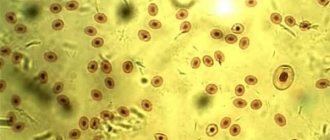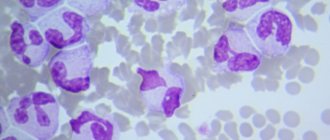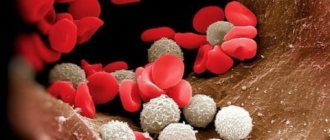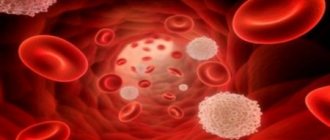What test is used to determine blood glucose levels?
Express diagnostics of glucose levels in children using a glucometer
There are several analysis methods to determine blood glucose levels, the most common include:
- Glucose oxidase test - blood serum is examined, the result is obtained using an automatic analyzer, which allows you to speed up the analysis process. For the study, blood is taken from a vein or from a finger, depending on the model of the device used.
- An express method for determining glucose levels - blood is tested using a portable glucometer that uses disposable test strips. Significant advantages of the method include ease of use and speed of analysis: many patients with diabetes use such devices on their own for daily monitoring of blood sugar levels in order to avoid complications. Very often, such devices are used by emergency doctors, since the glucometer performs an analysis in a matter of seconds.
- The hexokinase test is the most reliable and highly specific method; it allows you to accurately determine values that are much higher than normal (more than 20 mmol/l).
Normal blood sugar level in a newborn baby
In the first hours after birth, a general and biochemical blood test is taken from the baby’s heel.
In a newborn baby, normal blood glucose levels can range from 2.7 mmol/l to 4.4 mmol/l. It happens that in a newborn in the first hours of life it is below the lower limit of normal. This condition is physiological, but requires mandatory correction.
Low blood glucose levels are especially dangerous for premature babies. The shorter the fetus was in the womb during pregnancy, the more difficult it is for it to adapt to the environment and adapt to independent development.
A low value of this indicator is just as bad as a high one. The baby's brain tissue does not receive enough glucose. If the actual value of blood sugar in a newborn is below normal, then this condition is compensated for by frequent breastfeeding. When the glucose level is less than 2.2 mmol/l, a diagnosis of hypoglycemia is made and this condition requires drug correction or even resuscitation measures.
By the way, we recommend reading the article Gestational diabetes mellitus during pregnancy: what you need to know
Blood glucose levels

Normal indicators depend on age
The norm primarily depends on the age of the patient; for children the indicators are:
- Newborns (up to 1 month) - 2.8 - 4.4 mmol/l;
- Children under 14 years of age - 3.3 - 5.6 mmol/l;
- Adolescents (over 14 years old) - 4.1 - 5.9 mmol/l.
Normal values for adults:
- People under 60 years of age - 4.1 - 5.9 mmol/l;
- Persons from 60 to 90 years old - 4.6 - 6.4 mmol/l;
- Elderly people over 90 years old - 4.2 - 6.7 mmol/l.
At the same time, in most cases, indicators exceeding 7.0 mmol/l in a fasting blood test and 11.0 mmol/l, provided that the blood was donated after a meal or during a glucose tolerance test (“load”), are considered a serious alarm signal.
Reasons for deviations in indicators

The amount of glucose in the body depends on a large number of different factors.
Such factors are the child’s nutrition, the quality of the child’s digestive tract, the degree of influence on the metabolism of various hormones synthesized in the body. Such hormones are biologically active components produced by the pancreas and thyroid glands, hypothalamus, adrenal glands, etc.
If indicators are detected below normal levels, this may indicate prerequisites for the development of hypoglycemia, and detection of elevated levels may indicate a high probability of developing hyperglycemia.
If values above 6.1-6.2 mmol/l are recorded with several repeated measurements in adolescents or young children, the presence of diabetes mellitus is diagnosed.
New information: How to measure blood sugar levels at home without a glucometer?
The reasons for deviations from the physiological norm of glucose in a child’s body may be:
- Hereditary factors.
- Development of viral pathologies.
- Impaired motor activity and, as a consequence, the appearance of excess body weight.
- Violation of the rules of proper nutrition and malnutrition.
- Thyroid diseases.
- The presence of hyperfunctional activity of the adrenal glands.
Low rates occur in the following cases:
- starvation and dehydration of the child’s body;
- development of pathologies in the functioning of the digestive system;
- the occurrence of poisoning with heavy metals and drugs;
- the formation of neoplasms that provoke increased synthesis of insulin;
- pathologies in brain development;
- diseases of the blood system - leukemia, lymphoma, etc.
To prevent the development of a pathology such as diabetes in a child, it is necessary to carefully monitor the diet and the degree of physical activity on the body.
Hyperglycemia and diabetes in children

Hyperglycemia is a deviation of the amount of glucose towards an increase from the physiological norm. The most common reason for an increase in the amount is the development of diabetes.
In children under the age of 10 years, type 1 diabetes is detected in 90% of cases. Its occurrence is provoked by a lack of insulin, the hormone responsible for the utilization of glucose.
The exact causes of diabetes in childhood are unknown, but a hereditary predisposition to the pathology has been established.
Depending on the magnitude of the deviation from the norm, three stages of hyperglycemia are distinguished:
- Weakly expressed – 6.6-6.7 – 8.2-8.3 mmol/l.
- Moderate – 8.3-8.5 – less than 11.0 mmol/l.
- Severe stage – more than 11 mmol/l
Most often, damage to the child’s organs is observed even when the indicator remains at the level of 6.8-7.2 for a long time. If the value rises to 16.0, a state of precoma may occur, which manifests itself with vivid symptoms and is accompanied by impaired consciousness. When the amount in plasma increases to 33.0, the patient falls into a coma, which can be fatal.
When conducting a glucose tolerance test, it should be taken into account that the permissible values of sugar in the child’s blood are slightly higher than generally accepted values.
The following indicators can be considered normal for a child:
- an hour after providing a glucose load of more than 8.0 millimoles per liter, most often recorded in children is 8.7-8.8 mmol per liter;
- an hour and a half after applying the load, this indicator drops to a value of 7.8;
- after 2-2.5 hours the level is 6.5-6.8
If the measurement results vary within the acceptable range, then in the future it will be necessary to additionally check this physiological indicator periodically and maintain it within the required limits.
It should be remembered that in infants the immunity is weak and the occurrence of even the slightest deviation leads to the rapid progression of diabetes; this condition requires immediate therapeutic measures.
Reduced glucose level – development of hypoglycemia
Hypoglycemia is a condition in the baby’s body when there is a decrease in the amount of glucose in the blood plasma below acceptable levels. The most severe manifestation is the development of hypoglycemic coma followed by possible death.
New information: Blood sugar levels in type 2 diabetics
The diagnosis of hypoglycemia in a diabetic child is made due to the presence of a characteristic clinical picture and a decrease in sugars in the capillary blood below the minimum acceptable level.
In the clinical picture of the pathological condition, five successive stages are distinguished. Hypoglycemic coma, when carbohydrates in the body decrease below acceptable levels, develops acutely in a child, literally within a few minutes.
Before a dangerous condition occurs, the baby develops a whole range of signs, the main ones being trembling, increased sweating and increased heart rate.
In the event of a hypoglycemic coma, the child experiences:
- Pallor of the skin.
- The skin becomes moist due to increased sweating.
- The development of tachycardia and areflexia is observed.
- The child's pupils become narrow.
The first symptoms characteristic of the pathology appear in a child when glucose drops below 3.33. At a concentration of 2.7-1.5, all typical signs of hypoglycemia appear, and loss of consciousness occurs at a concentration of 1.38-1.5 millimoles per liter.
Elevated glucose levels: causes, symptoms
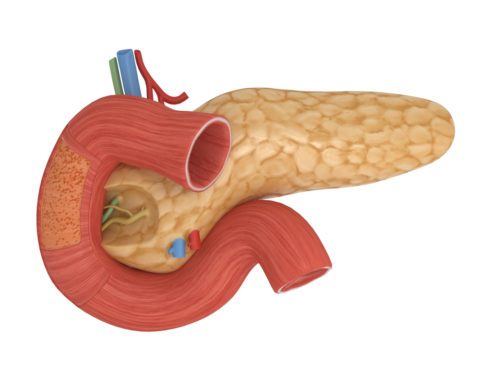
Pathology of the pancreas can cause hyperglycemia
A significantly elevated blood glucose level, as well as a stable slight excess of normal levels, may indicate the presence of the following diseases:
- Diabetes mellitus type I or II;
- Autoimmune pathology of the pancreas;
- Diseases of the endocrine system not related to diabetes mellitus (hyperthyroidism, Cushing's disease, acromegaly);
- Complicated course of mumps (“mumps”);
- Pancreatic tumors, including malignant ones;
- Acute and chronic pancreatitis.

A possible sign of high sugar is drinking too much
Symptoms of increased blood glucose levels are similar in children and adults; this pathological condition is most difficult to diagnose in young children. This is due to the fact that a child cannot always complain about what is bothering him. Parents need great care to suspect symptoms of hyperglycemia, the main of which include:
- Consuming an unusually large amount of liquid - the child may begin to prefer soups and other liquid foods, complain of a dry mouth, and ask to drink much more often than usual.
- Frequent urination - sometimes it can begin to occur uncontrollably even in those children who have long since left early childhood; parents often mistake this symptom for the onset of enuresis (urinary incontinence).
- Weight loss is often associated with decreased appetite and occasional vomiting.
- Lethargy, inability to concentrate attention - is manifested primarily by a slowdown in the child’s mental development and learning difficulties. Parents may mistake these warning signs for laziness and wait a long time to seek medical help for their child.
- Itchy skin - this deteriorates the appearance of the skin and makes it dry.
Causes of high and low sugar levels in children
High blood sugar levels may be caused by:
- heredity; high blood glucose levels may occur in newborns;
- viral infections (measles, mumps, chickenpox, viral hepatitis) that affect the functioning of the pancreas;
- impaired motor activity, resulting in the child becoming overweight;
- frequent colds, which causes disruption of the pancreas;
- poor nutrition, intake of foods rich in carbohydrates that are easily digestible (chocolate, flour products);
- thyroid diseases;
- hyperfunction of the adrenal glands.
In order to prevent a child from developing a disease such as diabetes, it is necessary to control his diet and physical activity.
Low glucose levels in children are observed in the following cases:
- fasting or dehydration;
- diseases of the digestive system;
- poisoning with salts of heavy metals, chemical compounds, drugs;
- neoplasms leading to the formation of large amounts of insulin;
- abnormalities of brain development;
- blood diseases (leukemia, lymphoma).
Reduced rate: causes, symptoms

Thyroid disease can lead to low blood sugar
A decrease in blood glucose levels is often associated with physiological reasons: insufficient nutrition and prolonged fasting before donating blood can significantly affect the test results. The rate is reduced in infants born prematurely and with low body weight, as well as in children of mothers who have diabetes.
In some cases, if the indicator is reduced, the doctor may suspect:
- Disease of the thyroid gland associated with a lack of production of its hormones;
- Simmonds disease;
- Diseases of the pancreas, including cancer;
- Severe liver dysfunction (viral and non-infectious hepatitis, cirrhosis);
- Oncological diseases of internal organs;
- Congenital metabolic diseases (galactosemia, fructosemia);
- Gierke's disease;
- Chemical poisoning and drug overdose;
- Diseases of the stomach and intestines that interfere with the absorption of food;
- Acute infectious diseases.
Prevention of diabetes mellitus in children
To maintain normal blood sugar levels and prevent diabetes in children, follow these simple recommendations.
- Monitor your child's nutrition. It should be healthy and balanced, with a predominance of proteins, complex carbohydrates, and plant products in the diet. If you are prone to diabetes, exclude sweets, fruits, fast food, snacks, baked goods, confectionery, and processed foods.
- Increase your child's physical activity: do morning exercises together, walk in the fresh air, send him to a sports section. This will help the body cope with excess glucose.
- Contact your pediatrician or endocrinologist if you notice the first signs of hyper- or hypoglycemia. If diabetes is confirmed, regularly monitor blood glucose levels with a special device, monitor the child’s nutrition and hygiene.
Blood sugar levels in children depend on age. Deviation of indicators up or down indicates pathological processes occurring in the body. Such changes are dangerous to health, so consultation with a doctor and correction of the condition is required.
Rate this article 5 5 (1 ratings)
What are the dangers of deviations from normal values?

Comas pose a major health risk
The most dangerous complications of high and low blood glucose levels are hypo- and hyperglycemic coma.
Hyperglycemic coma is also called diabetic coma because it most often develops in patients with diabetes mellitus. It comes on gradually, with a general deterioration in health, weakness, and headache. Symptoms similar to poisoning may appear (nausea, bloating, sometimes even vomiting); after about a day, the sick person falls into a precomatose state: consciousness is depressed, speech becomes slow. Without help, the patient then falls into an unconscious state called a coma.
Hypoglycemic coma is characterized by rapid development: the patient becomes covered in cold sweat, experiences attacks of rapid heartbeat, dizziness and fear. Then comes loss of consciousness, often accompanied by convulsions.
The described manifestations are typical for significantly deviating indicators, however, even with a slight increase in blood glucose levels that lasts for several months, vascular damage begins to develop, primarily affecting the kidneys and the lens of the eye. Without proper treatment, blood glucose levels can reach life-threatening levels very quickly.
Features of the disease and normal indicators for children
High blood sugar levels in a child occur due to the characteristics of insulin.
The situation may vary depending on how old the child is. If the child’s blood sugar level has changed, the cause may be physiological immaturity of the pancreas. This situation is typical for infants. The pancreas is not a primary organ, unlike the lungs, liver, heart and brain. Therefore, in the first year of a person’s life, the gland gradually matures.
A child aged 6 to 8, as well as 10 to 12 years old, may experience certain growth spurts. These are strong releases of growth hormone, which causes all structures of the body to increase in size.
Physiological changes sometimes occur as a result of this activation. Around the third year of life, the pancreas should begin to actively work and be a source of uninterrupted insulin.
It should be noted that blood sugar levels in 1-year-old children vary somewhat depending on the method of blood sampling and other factors. At about eight to ten years there is a tendency for the main indicators to decline.
To form an idea of the indicators in childhood, a special table is used. The sugar level for a one-year-old child is from 2.78 to 4.4 mmol/l. At the age of 2-6 years, glucose levels should be 3.3-5.0 mmol/l. When a child has reached 10-12 years of age or more, the figure is 3.3 - 5.5 mmol/l.
The listed blood sugar standards for children are used by endocrinologists and pediatricians all over the world. The indicators serve as the basis for diagnosing diabetes mellitus.
Clinical picture
According to Decree No. 56742, every diabetic can receive a unique remedy at a special price!
Doctor of Medical Sciences, Head of the Institute of Diabetology Tatyana Yakovleva
I have been studying the problem of DIABETES for many years. It's scary when so many people die and even more become disabled due to diabetes.
I hasten to report good news - the Endocrinological Research Center of the Russian Academy of Medical Sciences managed to develop a medicine that completely cures diabetes mellitus. At the moment, the effectiveness of this drug is approaching 100%.
Another good news: the Ministry of Health has achieved the adoption of a special program under which the entire cost of the drug is compensated. In Russia and the CIS countries, diabetics up to
On July 6th they can receive the product -
FREE!
Find out more>>
The baby is diagnosed in the following cases:
- if a blood test done on an empty stomach indicates that glucose is more than 5.5 mmol/l,
- if after two hours after receiving glucose, sugar is more than 7.7 mmol/l.
In the blood of children under 8 months, the glucose level is low, since there are certain features of metabolic processes. As a child grows, he needs more energy, which means more glucose. When a child reaches five years of age, the blood sugar level becomes similar to that of an adult, which is completely normal.
If diabetes is confirmed in one of the twins, then the second has a high risk of getting sick. In type 1 diabetes, in 50% of cases the disease develops in the other twin.
Expert opinion
Shalaeva Svetlana Sergeevna
endocrinologist, highest category, 18 years of experience
With type 2 disease, the second twin is most likely to develop the pathology, especially if they are overweight.
Indications for the test

There are certain indications for analysis
Indications for determining glucose levels are:
- Existing endocrinological diseases (diabetes mellitus, hypothyroidism);
- Diseases of the liver and pancreas;
- Slowing down the rate of mental and physical development of the child;
- Diseases of the gastrointestinal tract;
- Hereditary diseases (enzymopathies).
In addition, the analysis is indicated for infants born to mothers with diabetes and children who have problems with excess weight.
How does the body understand when it is necessary to normalize sugar levels?
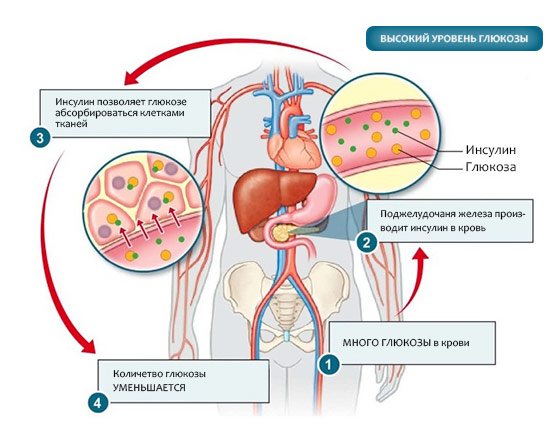
During the day, a normal balance between insulin and glucogen is maintained in the blood. Let's give an example of what processes occur in the body immediately after eating. After you eat, your body gets amino acids, fatty acids and glucose from food. The body analyzes them and triggers beta cells in your pancreas to produce insulin in the blood. This process tells the pancreas not to release glucogen in order to encourage the body to use glucose as a source of nutrition. Insulin rises along with sugar levels and sends it to muscle cells and the liver for use as an energy source. This keeps the levels of glucose, amino acids and fatty acids in the blood from going too high and helps keep sugar levels stable.
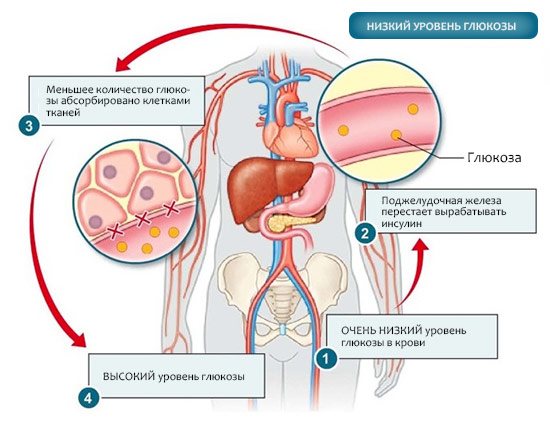
There may be times when you skipped your breakfast or during the night your body needs additional resources to maintain normal sugar levels until the next meal. When you haven't eaten, your body's cells still need glucose to function properly. When blood sugar levels drop due to lack of food, alpha cells in the pancreas begin to produce glucogen to stop insulin production and instruct the liver and kidneys to produce glucose from glucogen stores through metabolic processes. This helps keep your sugar levels stable and avoid unpleasant health consequences.
ul
Blood test for sugar in children

Type 1 diabetes is common in childhood
A blood sugar test first of all makes it possible to identify at an early stage a serious disease that most often occurs at a very young age - type 1 diabetes. While “adult” diabetes mellitus occurs more often closer to old age and is associated with abuse of sugar and other fast carbohydrates, type I diabetes mellitus is a disease that occurs due to autoimmune damage to pancreatic cells and is not associated with errors in diet.
It is because of this prejudice that diabetes can only be caused by an excess of sweet foods that many parents consider blood tests for sugar in children unnecessary. This is a wrong position, especially if the child has health problems and his or her health worsens for no reason.
A blood sugar test is also indicated for children whose close relatives have autoimmune diseases. Such diseases include not only type I diabetes mellitus, but also rheumatoid arthritis, diffuse toxic goiter, Hashimoto's thyroiditis, systemic lupus erythematosus and many others.
How the body controls blood sugar levels
It is very important that your sugar levels are normal. It should not be allowed to be a little higher or a little lower, if it falls too much and goes beyond the normal range, the consequences can be very serious, such as:
- Confusion, loss of consciousness and subsequent coma.
- If your blood sugar is high, your vision may become dark and blurry, and you will feel very tired.
Principles of regulation
| Sugar level | Effects on the pancreas | Effects on the liver | Effect on glucose levels |
| High | This sugar level gives a signal to the pancreas to produce insulin. | The liver converts any excess glucose into glucagon. | Sugar levels drop. |
| Short | Low levels signal the pancreas to stop producing insulin before it is needed again. At the same time, glucagon is released. | The liver stops processing excess glucose into glucagon due to its release from the pancreas. | Sugar levels are rising. |
| Normal | When you eat, glucose enters the bloodstream and signals the pancreas to release insulin. This helps glucose enter the cells and give them the energy they need. | The liver is at rest, not producing anything, since sugar levels are normal. | Sugar levels are normal and stay the same. |
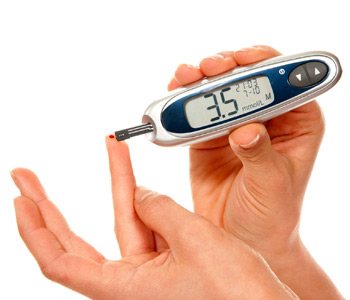
If the sugar level is between 3.6 and 5.8 mmol/l or 65 and 105 mg/dl, then this is said to be the normal blood sugar level of a healthy person.
To maintain normal blood sugar, our pancreas produces two different hormones that maintain it at the desired level - insulin and glucagon (a polypeptide hormone).
Insulin
Insulin is a hormone produced by pancreatic cells that is released in response to glucose. Insulin is needed by most cells in our body, including fat cells, muscle cells, and liver cells. This is a protein (protein), which consists of 51 types of amino acids and performs the following functions:
- Tells muscle and liver cells to accumulate converted glucose in the form of glucogen.
- Helps fat cells generate fat by converting glycerol and fatty acids.
- Instructs the kidneys and liver to stop producing their own glucose through a metabolic process (gluconeogenesis).
- Stimulates muscle and liver cells to produce protein from amino acids.
To summarize the above, we can conclude that insulin helps the body absorb nutrients after meals, lowering blood sugar, amino acids and fatty acids.
Glucagon
Glucagon is a protein produced by alpha cells. As for sugar levels, it has a similar effect on cells, but the opposite of insulin. When sugar levels are low, glucogen instructs muscle and liver cells to activate glucose in the form of glucogen, through glycogenolysis. Stimulates the kidneys and liver to generate its own glucose through gluconeogenesis.
As a result, glucagon collects glucose from various sources within our body in order to maintain it at sufficient levels. If this does not happen, then the sugar level becomes very low.
ul
What can influence the results of the analysis?

Drugs may affect test results
The accuracy of the analysis is negatively affected by:
- Physical activity immediately before donating blood;
- Emotional stress, severe fear of the procedure;
- Stressful conditions;
- Taking certain medications (it is worth discussing changes in your medication regimen with your doctor).
Elevated glucose levels can sometimes be detected in healthy children for a number of physiological reasons, but the values never exceed 7.0 or 11.0 mmol/l on an empty stomach and after meals, respectively. Any, even the most minor, deviation from the norm in this analysis is a reason to consult your doctor as soon as possible.
What may affect the results of the study?
Falsely elevated test results can be detected in patients undergoing treatment with glucocorticosteroids, growth hormone, estrogens, caffeine, and thiazides.
Elevated sugar levels can also be detected in smokers.
Low blood sugar may occur in individuals being treated with anabolic steroids, propranolol®, salicylates, antihistamines, insulin®, or oral antihyperglycemic tablets.
Low sugar can also occur due to poisoning with chloroform or arsenic, in patients with leukemia or erythrocythemia.
How to submit?
An analysis to determine blood sugar levels in adolescents and young children is carried out in a laboratory; you can do this yourself at home, using a portable glucometer. The material is collected from a finger on an empty stomach. Do not forget that after eating, within 2 hours, the concentration of sugar in the plasma is maximum, so it is important not to violate the condition, do not feed an infant or older child before taking tests, the child’s last meal should be no later than 9-12 hours before procedures.
In diabetes, the pancreas in the child's body does not function properly.
The blood sugar level in a newborn child should not exceed 4.3 mmol/g, the glucose level of a teenager should be normal to 5.5 mmol/l. However, if low or high blood sugar is detected, you should not immediately panic, since it is not always possible to get a correct blood test for sugar in children the first time. If an infant or older child suddenly experiences a decrease or increase in sugar levels, this may be due to other internal problems:
- experience, emotional excitability;
- diseases of internal organs, including the pancreas;
- neurogenic disorders, congenital pathologies of the central nervous system;
- internal bleeding.
To confirm or refute the diagnosis, it is recommended to undergo a glucose tolerance test, which will help to accurately determine whether the child’s sugar is low or high. To do this, first take blood from a finger on an empty stomach, then give the child a glucose solution to drink. After 30 minutes, the first sample is taken, and so every half hour, blood is drawn for 2 hours and a graph of plasma glucose concentration is drawn up. The normal blood sugar level in children is no more than 6.9 mmol/l. If the readings approach 10.5 mmol/l, this is high sugar, and there is a suspicion of the development of prediabetes. If the value has increased by more than 10.5 mmol/l, and additional diagnostic studies agree with the previously obtained data, a diagnosis of diabetes mellitus is made.
How is blood taken and what methods are used to determine blood sugar?
Venous and capillary blood is suitable for testing blood glucose levels.
The most commonly used enzymatic methods for determining blood glucose are glucose oxidase and hexokinase.
The glucose oxidase method involves determining the amount of hydrogen peroxide that is formed in an equivalent amount of glucose in the blood under the action of the enzyme glucose oxidase.
The hexokinase method is more highly specific. Hexokinase catalyzes another reaction where the concentration of glucose is measured by the amount of NADPH2 produced.

Consequences
Severe hypoglycemia in a child can manifest itself as follows:
- the baby becomes restless and overly active;
- he may ask for something sweet, after which excitement sets in for a short time, the child sweats, turns pale, becomes dizzy, or loses consciousness.
Sweet foods or intravenous glucose can help improve the condition almost immediately.
The symptoms of hyperglycemia are in many ways similar to those characteristic of hypoglycemia. So, the child may feel weak and have a headache. An increase in blood glucose levels is also characterized by suddenly cold extremities, a feeling of dry mouth and thirst, itchy skin and gastrointestinal problems.
Under no circumstances should such symptoms be ignored, since prolonged hyperglycemia without treatment negatively affects brain activity. Hypoglycemia is dangerous due to the possible onset of hypoglycemic coma, which can be fatal.
